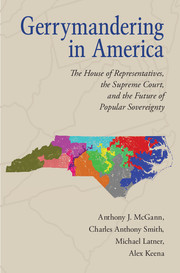 Gerrymandering in America
Gerrymandering in America Book contents
- Frontmatter
- Contents
- 1 The Unnoticed Revolution
- 2 The Jurisprudence of Districting
- 3 Measuring Partisan Bias
- 4 Geographic Explanations for Partisan Bias
- 5 Political Explanations of Partisan Bias
- 6 Constitutional Implications of Vieth: The Revenge of the Anti-Federalists
- 7 Answering Justice Scalia's Challenge to Equality: Does Equal
- 8 Conclusion: Vieth, Majority Rule, and One Person, One Vote
- Bibliography
- Index
3 - Measuring Partisan Bias
Published online by Cambridge University Press: 05 March 2016
- Frontmatter
- Contents
- 1 The Unnoticed Revolution
- 2 The Jurisprudence of Districting
- 3 Measuring Partisan Bias
- 4 Geographic Explanations for Partisan Bias
- 5 Political Explanations of Partisan Bias
- 6 Constitutional Implications of Vieth: The Revenge of the Anti-Federalists
- 7 Answering Justice Scalia's Challenge to Equality: Does Equal
- 8 Conclusion: Vieth, Majority Rule, and One Person, One Vote
- Bibliography
- Index
Summary
We claimed in Chapter 1 that there was a sharp increase in partisan bias as a result of the redistricting that followed the 2010 Census. In this and the following two chapters, we provide systematic evidence for this and ask why this has happened.
Empirically, we have two main tasks. The first is to measure partisan bias at both the national and state level. This will allow us to test whether there has been a significant increase in partisan bias following the 2010 districting round. This is the task of this chapter. Assuming that there is partisan bias, the second task is to test various explanations of why the level of bias has changed and why bias occurs where it does. We have hypothesized that this is a thoroughly political phenomenon – state governments pursue partisan advantage when they are unconstrained by the courts. However, other explanations are possible. Chapter 4 considers nonpolitical alternative explanations. For example, it has been suggested that bias against the Democratic Party is inevitable because of demographic reasons, such as the fact that Democratic voters are concentrated in urban areas or the fact that it is necessary to draw majority-minority districts to comply with the Voting Rights Act. Chapter 5 considers political explanations for the patterns of bias we see. It asks whether we can explain the bias we observe in terms of the political motivations and capabilities of those in charge of drawing districts.
We make use of the established methodology for measuring partisan bias in districting (see Gelman and King 1994b). This has been widely applied, tested, and peer reviewed. It is based on the idea of symmetry: If the Democrats get 52% of the votes and win 60% of the seats as a result, then if the Republicans were to win 52% of the vote in the next election they should get 60% of the seats. We can measure how much a districting plan violates symmetry by estimating how many seats a party would win in the event of different levels of popular support. While popular support varies from election to election, the pattern of support between districts remains quite stable.
- Type
- Chapter
- Information
- Gerrymandering in AmericaThe House of Representatives, the Supreme Court, and the Future of Popular Sovereignty, pp. 56 - 96Publisher: Cambridge University PressPrint publication year: 2016


